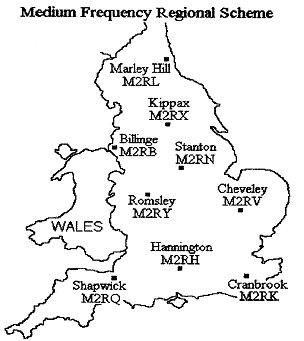|
In 1935 this idea was taken up by Manchester City Police on a rather grander scale. They introduced an MF system which covered no less than six police force areas - Manchester, Bolton, Oldham, Rochdale, Salford and Cheshire (Altrincham Division). The radio station was located at Heaton Park, Manchester, and all of the fixed and mobile equipment was manufactured at Heaton Park by a team of technicians led by Mr I. Auchterlonie and
Mr O.B. Kellett, who were now serving policemen. Manchester's scheme was predominantly one-way, but a single two-way link was employed for communication with Manchester's CID night squad van.
Police Interception Unit
To operate their new radio system Newcastle City Police had to train a number of officers in morse code This had a rather unexpected consequence in 1938 when a number of officers from the City Police were asked to set up an interception unit for the Radio Security Service. They, along with some 1200 other volunteers throughout the country, gave valuable service throughout World War II intercepting messages from both friendly and enemy sources and providing a large part of the raw material for the famous Ultra decrypts.
The Police Radio Interception Unit operated from the City's West End Police Station on Arthurs Hill using two Hallicrafters receivers, a Super Skyrider and a Skyrider 23, The vast majority of the intercepted messages were, of course, in code and were simply forwarded to the RSS headquarters in London to be decoded. Rarely did the volunteer interceptors have any idea as to the nature or significance of the messages, but on one occasion they got just a clue. At 1905 on June 15th 1941 PC Ed Barron picked up the following message on 7050 KHz: "SOS SOS SOS DE (from) OKR FOR ENGLAND PSE (please) QSP (forward) TO GENERAL INGR IN ENGLAND" then followed 25 five- figure code groups, and finally "AR (end of message) PRAGUE"- Most unusually the RSS sent a personal message of thanks to the officer concerned which ended "Apparently this message is of great importance". (Tyne & Wear Archives Service Ref. T136-87).
Following the undoubted success of the shared MF telegraphy schemes in Newcastle-upon-Tyne and Manchester, the Home Office formulated the Medium Frequency Regional Scheme, which entailed a network of Regional Wireless Stations covering the entire country.
The Chief Constable of Nottingham City Police, at the instigation of radio amateur Mr H.B. Old, had shown particular interest in the idea, so in 1938 the Home Office approved the setting up of the first Regional Wireless Station at Stanton, Nottingham which was to serve the counties of Nottinghamshire, Derbyshire, Leicestershire, Lincolnshire, Northamptonshire and Rutland, as well as a number of city forces in the area, using a single frequency in the 1600-1800 kHz band. Stanton opened on July 1st. 1939 with Mr H.B. Old as Regional Engineer and Mr O.B. Kellett as Experimental Wireless Technician.
As with the Newcastle and Manchester systems, messages for transmission to vehicles were passed to the control room by private-wire telephone links, but unlike those systems, the new station operated on telephony (voice) rather than telegraphy. It would no longer be necessary for large numbers of police officers to be trained in morse code.
Although the Stanton station was essentially experimental in nature, it quickly proved its worth, and after only a few weeks of operation, the Home Office approved the building of a further eight similar stations to complete coverage of England. Even the outbreak of war did not interfere with this programme, and site-selection and building work went ahead without delay. Overseeing the work was the newly formed Communications Branch of the Home Office.
Up to this time the Post Office had issued callsigns for individual police schemes as required, so there was GWW for the Met, GTM in Liverpool, GWB in Manchester and MVQ in Nottingham etc. With the formation of the Home Office Communications Branch, it was decided that they would take over responsibility for all police callsign allocations using the series M2AA-M2ZZ.
 |
By the end of 1942 all nine Regional Wireless Stations were in operation. The Marley Hill station was typical. It was erected alongside a distribution reservoir on an elevated site in the north of County Durham about three and a half miles south-west of Newcastle-upon-Tyne. The site was dominated by a 140 foot mast radiator and nearby was a flat-roofed building housing the transmitters, control room and offices.
The main transmitter was of 1 Kilowatt and there was a 300 watt standby unit to ensure continuity of service; both could quite adequately cover the whole of the station's service area - Northumberland, County Durham and the North Riding of Yorkshire. Although Marley Hill, like the other stations in the MF Scheme, provided only a one-way service it did have receiving facilities. These enabled Marley Hill to continuously monitor the transmissions of the neighbouring Regional Wireless Stations at Kippax and Billinge. As these stations also monitored Marley Hill and each other, two-way communication between the wireless stations was possible.
continued on page 2 ....
Acknowledgement: Brian Pears for the article and Kevin Carrig source.
|